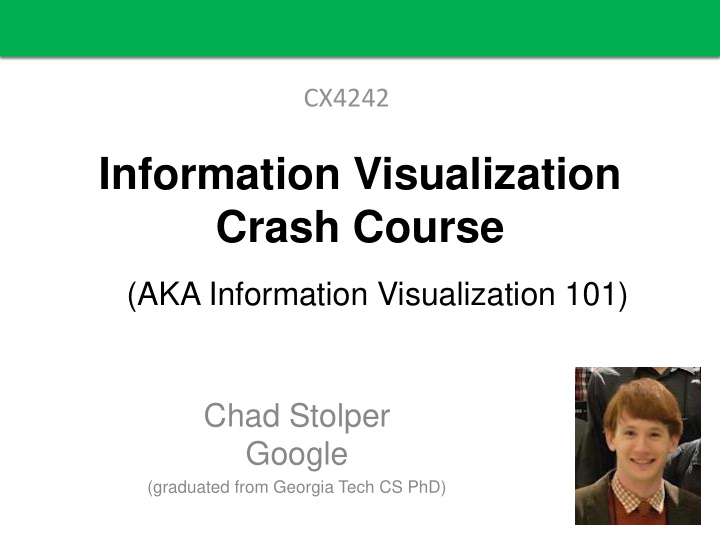



CX4242 Information Visualization Crash Course (AKA Information Visualization 101) Chad Stolper Google (graduated from Georgia Tech CS PhD) 1
What is Infovis? Why is it Important? Human Perception Chart Basics (If Time, Some Color Theory) The Shneiderman Mantra Where to Learn More 2
What is Information Visualization? 3
Information Visualization “The use of computer -supported, interactive , visual representations of abstract data to amplify cognition .” Card, Mackinlay, and Shneiderman 1999 4
Communication Exploratory Data Analysis (EDA) 5
Communication (gone wrong) 6
7
Edward Tufte An American statistician and professor emeritus of political science, statistics, and computer science at Yale University. He is noted for his writings on information design and as a pioneer in the fie ld of data visualization. -Wikipedia X 8
Space Shuttle Challenger January 28, 1986 Morning Temperature: 31 ° F 9
10
Tufte, E. R. (2012). Visual explanations: images and quantities, evidence and narrative . Cheshire, CT: Graphics Press. 11
Most Watched Science Experiment Richard Feynman, Physics Nobel laureate explained how rubber became rigid in cold temperate YouTube video: https://youtu.be/6Rwcbsn19c0 Video originally from: http://www.FeynmanPhysicsLectures.com 13
How did this happen? 14
Engineers at Morton Thiokol , the rocket maker, presented on the day before and recommended not to launch. Tufte, E. R. (2012). Visual explanations: images and quantities, evidence and narrative . Cheshire, CT: Graphics Press. 15
19
24
25
26
27
28
So, communication is extremely important . Visualization can help with that – communicate ideas and insights . 29
http://www.ted.com/talks/hans_rosling_shows_the_best_stats_you_ve_ever_seen.html 30
Visualization can also help with Exploratory Data Analysis (EDA) But why do you need to explore data at all??? 31
“There are three kinds of lies: lies, damned lies, and statistics.” https://en.wikipedia.org/wiki/Lies,_damned_lies,_and_statistics 33
Mystery Data Set 34
Mystery Data Set Property Value 9 mean( x ) 11 variance ( x ) 7.5 mean( y ) 4.122 variance ( y ) 0.816 correlation ( x,y ) y = 3 + 0.5x Linear Regression Line 35
36
37
38
39
Anscombe’s Quartet https://en.wikipedia.org/wiki/Anscombe%27s_quartet 40
Anscombe’s Quartet Sanity Checking Models Outlier Detection 41
Data visualization leverages human perception 43
Name the five senses. 44
Sense Bandwidth (bits/sec) Sight 10,000,000 Touch 1,000,000 Hearing 100,000 Smell 100,000 Taste 1,000 http://www.britannica.com/EBchecked/topic/287907/information-theory/214958/Physiology 45
A (Simple) Model of Human Visual Perception 46
A (Simple) Model of Human Perception Stage 2 Stage 1 Parallel detection of Serial processing of basic features into object identification and an iconic store spatial layout 47
Stage 1: Pre-Attentive Processing Rapid Parallel Automatic (Fleeting = lasting for a short time) 48
Stage 2: Serial Processing Relatively Slow (Incorporates Memory) Manual 49
Stage 1: Pre-Attentive Processing The eye moves every 200ms (so this processing occurs every 200ms-250ms) 50
Example 1281768756138976546984506985604982826762 9809858458224509856458945098450980943585 9091030209905959595772564675050678904567 8845789809821677654876364908560912949686 51
Example 1281768756138976546984506985604982826762 9809858458224509856458945098450980943585 9091030209905959595772564675050678904567 8845789809821677654876364908560912949686 52
A few more examples from Prof. Chris Healy at NC State 53
Left Side Right Side 54
Raise your hand if a RED DOT is present… (On the left or on the right?) 55
56
57
Color (hue) is pre-attentively processed. 58
Raise your hand if a RED DOT is present… 59
60
Shape is pre-attentively processed. 61
Determine if a RED DOT is present… 62
63
Hue and shape together are NOT pre-attentively processed. 64
Pre-Attentive Processing • • length hue • • width lightness • • size flicker • • curvature direction of motion • • number binocular lustre • • terminators stereoscopic depth • • intersection 3-D depth cues • • closure lighting direction 65
Stephen Few “Now You See It” pg. 39 66
Pre-Attentive Cognitive 67
Gestalt Psychology Berlin, Early 1900s 68
Gestalt Psychology Goal was to understand pattern perception Gestalt (German) = “seeing the whole picture all at once” instead of a collection of parts Identified 8 “Laws of Grouping” http://study.com/academy/lesson/gestalt-psychology-definition-principles-quiz.html 69
Gestalt Psychology 1. Proximity 7. Good Gestalt 2. Similarity 8. Past Experience 3. Closure 4. Symmetry 5. Common Fate 6. Continuity 70
How many groups are there? 71
72
Proximity 73
How many groups are there? 74
75
Similarity 76
How many shapes are there? 77
78
Closure 79
How many items are there? 80
( ) { } [ ] 81
Symmetry ( ) { } [ ] 82
How many sets are there? 83
84
Common Fate 85
How many objects are there? 86
87
Continuity 88
How many objects are there? 89
90
Good Gestalt 91
What is this word? 92
CLIP 93
Past Experience CLIP 94
Pre-Attentive Processing Gestalt Laws 99
Detect Quickly 100
Detect quickly does NOT mean detect accurately Ideally you want both. 101
Crowdsourcing Graphical Perception: Using Mechanical Turk to Assess Visualization 102 Design.Heer and Bostock. Proc ACM Conf. Human Factors in Computing Systems (CHI) 2010, p. 203 – 212.
April 10–15, 2010, Atlanta, GA, USA Crowdsourced Results 1.0 1.5 2.0 2.5 3.0 Log Error McGill’ Crowdsourcing Graphical Perception: Using Mechanical Turk to Assess Visualization 103 Design.Heer and Bostock. Proc ACM Conf. Human Factors in Computing Systems (CHI) 2010, confidence p. 203 – 212. significantly find McGill’ confidence ⇥ confident squarified “Squar ’ ified” modified ified McGill’ qualification “quick ” ⇥ first
Mackinlay, 1986 104
Stephen Few “Now You See It” pg. 41 105
What does this tell us? 106
Barcharts, scatterplots, and line charts are really effective for quantitative data 40 40 20 20 0 0 0 20 40 0 20 40 0 20 40 107
(and for statistical distributions) Tukey Box Plots 108
109
Outliers Largest < Q3 + 1.5 IQR Largest < Q3 Median Smallest > Q1 Smallest > Q1 - 1.5 IQR 110
Tufte’s Chart Principles Edward Tufte 111
Tufte’s Chart Principles DO NOT LIE! Maximize Data-Ink Ratio Minimize Chart Junk 114
Tufte’s Chart Principles DO NOT LIE! Maximize Data-Ink Ratio Minimize Chart Junk 115
116
Recommend
More recommend